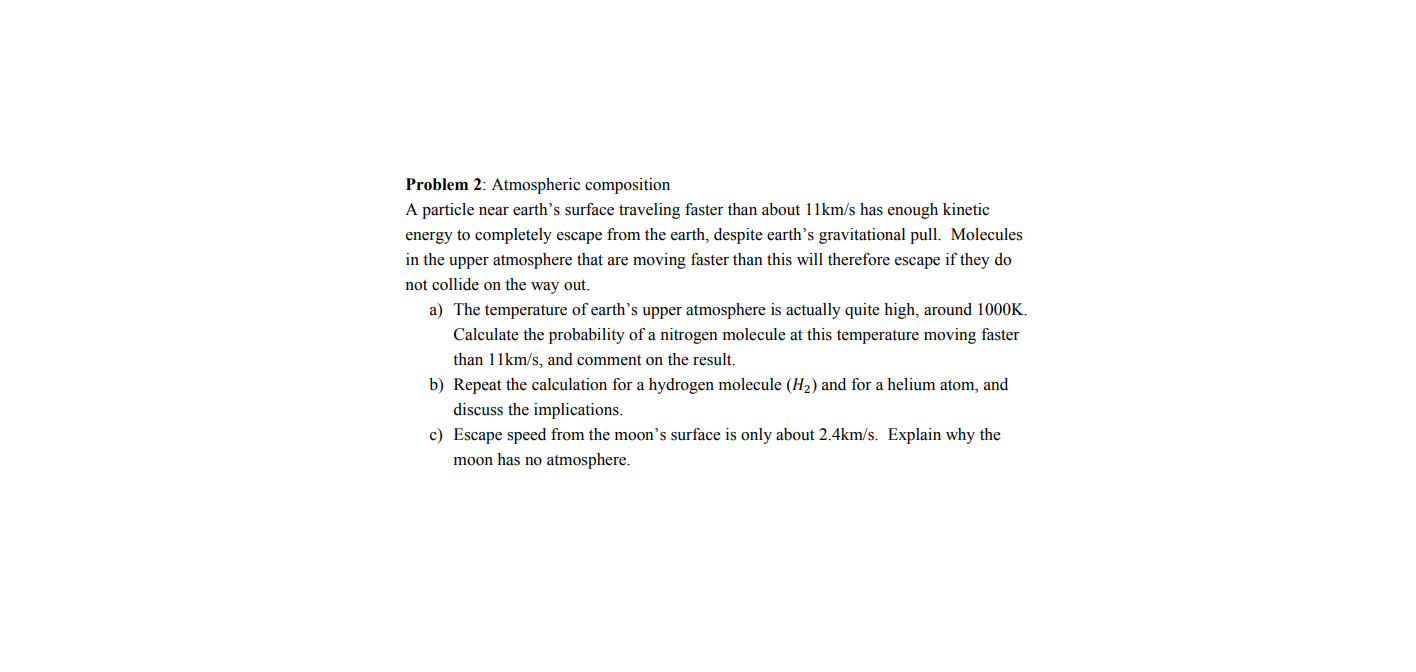Problem 2: Atmospheric composition A particle near earth's surface traveling faster than about 11km/s has enough kinetic energy to completely escape from the earth, despite earth's gravitational pull. Molecules in the upper atmosphere that are moving faster than this will therefore escape if they do not collide on the way out. a) The temperature of earth’s upper atmosphere is actually quite high, around 1000K. Calculate the probability of a nitrogen molecule at this temperature moving faster than 11km/s, and comment on the result. b) Repeat the calculation for a hydrogen molecule (H2) and for a helium atom, and discuss the implications. c) Escape speed from the moon's surface is only about 2.4km/s. Explain why the moon has no atmosphere.
Problem 2: Atmospheric composition A particle near earth's surface traveling faster than about 11km/s has enough kinetic energy to completely escape from the earth, despite earth's gravitational pull. Molecules in the upper atmosphere that are moving faster than this will therefore escape if they do not collide on the way out. a) The temperature of earth’s upper atmosphere is actually quite high, around 1000K. Calculate the probability of a nitrogen molecule at this temperature moving faster than 11km/s, and comment on the result. b) Repeat the calculation for a hydrogen molecule (H2) and for a helium atom, and discuss the implications. c) Escape speed from the moon's surface is only about 2.4km/s. Explain why the moon has no atmosphere.
Related questions
Question

Transcribed Image Text:Problem 2: Atmospheric composition
A particle near earth's surface traveling faster than about 11km/s has enough kinetic
energy to completely escape from the earth, despite earth's gravitational pull. Molecules
in the upper atmosphere that are moving faster than this will therefore escape if they do
not collide on the way out.
a) The temperature of earth’s upper atmosphere is actually quite high, around 1000K.
Calculate the probability of a nitrogen molecule at this temperature moving faster
than 11km/s, and comment on the result.
b) Repeat the calculation for a hydrogen molecule (H2) and for a helium atom, and
discuss the implications.
c) Escape speed from the moon's surface is only about 2.4km/s. Explain why the
moon has no atmosphere.
Expert Solution
This question has been solved!
Explore an expertly crafted, step-by-step solution for a thorough understanding of key concepts.
This is a popular solution!
Trending now
This is a popular solution!
Step by step
Solved in 7 steps with 8 images
